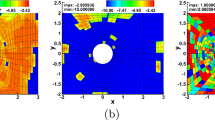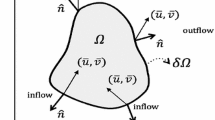Abstract
This work revisits an idea that dates back to the early days of scientific computing, the energy method for stability analysis. It is shown that if the scalar non-linear conservation law
is approximated by the semi-discrete conservative scheme
then the energy of the discrete solution evolves at exactly the same rate as the energy of the true solution, provided that the numerical flux is evaluated by the formula
where
With careful treatment of the boundary conditions, this provides a path to the construction of non-dissipative stable discretizations of the governing equations. If shock waves appear in the solution, the discretization must be augmented by appropriate shock operators to account for the dissipation of energy by the shock waves. These results are extended to systems of conservation laws, including the equations of incompressible flow, and gas dynamics. In the case of viscous flow, it is also shown that shock waves can be fully resolved by non-dissipative discretizations of this type with a fine enough mesh, such that the cell Reynolds number ≤2.
Similar content being viewed by others
References
Richtmyer, R.D., Morton, K.W.: Difference Methods for Initial Value Problems. Interscience, New York (1967)
Honein, A.E., Moin, P.: Higher entropy conservation and numerical stability of compressible turbulence simulations. J. Comput. Phys. 201, 531–545 (2004)
Lax, P.D., Wendroff, B.: Systems of conservation laws. Commun. Pure. Appl. Math. 13, 217–137 (1960)
Gustafsson, B., Olsson, P.: High-order centered difference schemes with sharp shock resolution. J. Sci. Comput. 11, 229–260 (1996)
Godunov, S.K.: A difference method for the numerical calculation of discontinous solutions of hydrodynamic equations. Math. Sb. 47, 271–306 (1959)
Boris, J.P., Book, D.L.: Flux corrected transport, SHASTA, a fluid transport algorithm that works. J. Comput. Phys. 11, 38–69 (1973)
Van Leer, B.: Towards the ultimate conservative difference scheme, II, monotonicity and conservation combined in a second order scheme. J. Comput. Phys. 14, 361–370 (1974)
Roe, P.L.: Approximate Riemann solvers, parameter vectors and difference scheme. J. Comput. Phys. 43, 357–372 (1981)
Harten, A.: High resolution schemes for hyperbolic conservation laws. J. Comput. Phys. 49, 357–393 (1983)
Liou, M.S., Steffen, C.J.: A new flux splitting scheme. J. Comput. Phys. 107, 22–39 (1993)
Jameson, A.: Analysis and design of numerical schemes for gas dynamics 1. Artificial diffusion, upwind biasing, limiters and their effect on accuracy and multigrid convergence. Int. J. Comput. Fluid Dyn. 4, 171–218 (1995)
Jameson, A.: Analysis and design of numerical schemes for gas dynamics 2. Artificial diffusion and discrete shock structure. Int. J. Comput. Fluid Dyn. 5, 1–38 (1995)
Godunov, S.K.: An interesting class of quasilinear systems. Dokl. Akad. Nauk USSR 139, 521 (1961)
Mock, M.S.: Systems of conservation laws of mixed type. J. Differ. Equ. 37 (1980)
Harten, A.: On the symmetric form of systems of conservation laws with entropy. J. Comput. Phys. 49, 151–164 (1983)
Mattsson, K.: Boundary operators for summation-by-parts operators. J. Sci. Comput. 18, 133–153 (2003)
Shu, C.W.: Total-variation-diminishing time discretizations. SIAM J. Sci. Stat. Comput. 9, 1073–1084 (1988)
Gottlieb, S., Shu, C.W., Tadmor, E.: Strong stability-preserving high-order time discretization methods. SIAM Rev. (2006)
Jameson, A., Baker, T.J., Weatherill, N.P.: Calculation of inviscid transonic flow over a complete aircraft. AIAA Paper 86-0103, AIAA 24th Aerospace Sciences Meeting, Reno, January 1986
Ham, F., Mattsson, K., Iaccarino, G., Moin, P.: Towards time-stable and accurate les on unstructured grids. In: Complex Effects in Large Eddy Simulation, Limassol, September 2005
Hughes, T.J., Franca, L.P., Mallet, M.: A new finite element formulation for computational fluid dynamics: I. Symmetric forms of the compressible Euler and Navier Stokes equations and the second law of thermodynamics. Comput. Methods Appl. Mech. Eng. 54, 223–234 (1986)
Gerritsen, M., Olsson, P.: Designing an efficient solution strategy for fluid flows. J. Comput. Phys. 129, 245–262 (1996)
Yee, H.C., Vinokur, M., Djomehri, M.J.: Entropy splitting and numerical dissipation. J. Comput. Phys. 162, 33–81 (2000)
MacCormack, R.W., Paullay, A.J.: The influence of the computational mesh on accuracy for initial value problems with discontinuous or non-unique solutions. Comput. Fluids 2, 339–361 (1974)
Jameson, A., Schmidt, W., Turkel, E.: Numerical solutions of the Euler equations by finite volume methods using Runge-Kutta time-stepping schemes. AIAA Paper 81-1259, AIAA 14th Fluid and Plasma Dynamic Conference, Palo Alto, June 1981
Author information
Authors and Affiliations
Corresponding author
Rights and permissions
About this article
Cite this article
Jameson, A. The Construction of Discretely Conservative Finite Volume Schemes that Also Globally Conserve Energy or Entropy. J Sci Comput 34, 152–187 (2008). https://doi.org/10.1007/s10915-007-9171-7
Received:
Accepted:
Published:
Issue Date:
DOI: https://doi.org/10.1007/s10915-007-9171-7




